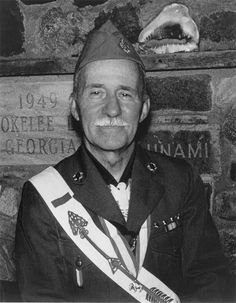Get Today in Masonic History into your Inbox. Sign up today for one of our email lists!
Need an article for your Trestleboard/Newsletter see our Use Policy
Edward Urner Goodman Passes Away

Today in Masonic History Edward Urner Goodman passes away in 1980.
Edward Urner Goodman was an American Boyscout leader.
Goodman was born on May 15th, 1891 in Philadelphia, Pennsylvania. He attended Central High School graduating in 1909. While in high school he developed a life long love of music playing the piano and violin. He also composed songs, included a song he submitted for his senior class. Unfortunately the song was rejected. In 1911 he enrolled in Philadelphia School of Pedagogy, a teaching school run by the Philadelphia school district for young men who graduated from Central High School and were interested in becoming elementary school teachers. He graduate from the Philadelphia School of Pedagogy in 1913 before doing graduate work at Temple University which was just a few blocks from the school.
Also in 1911, Goodman became involved in the the Scouting program, becoming the Scoutmaster of Troop 1 in Philadelphia. At the age of 20 he appears to be the second youngest Scoutmaster in the history of the Boy Scouts of America. He helped to grow the troop to more than 100 scouts.
In 1915, Goodman became a full-time professional in the Boy Scout organization. He became a field executive serving as the director of the Philadelphia Scout Council's summer camp. In 1917 he was promoted to the Scout executive of the Philadelphia Council. Goodman's career with the Philadelphia Council was interrupted by World War I when he was drafted. He served until 1918 in the Army when he was discharged. He returned to the Philadelphia Council as Scout Executive serving until 1927. From 1927 to 1931 he was transferred to the larger Chicago Area Council where he turned around the finances and increased membership in the council.
In 1931, Goodman was promoted to the position of national program director for the Boy Scouts of America. In he position, Goodman had many successes the most notable was in 1937 when he organized the first national Scout Jamboree in Washington, D.C. Goodman setup a media tent to ensure coverage. The tent accommodated 626 news reporters. During the jamboree there were 64 news releases, 11 newsreels made, 53 magazine articles written and it was covered by the three major radio networks of the time who combined made 19 hours of live on-site jamboree coverage. President Franklin D. Roosevelt even visited the event.
During his time in the Philadelphia Council, Goodman had his most recognizable achievement. While running the summer camp, Goodman and his assistant camp director started a program which recognized scouts who exemplified the Scout Oath and Scout Law in the eyes of their fellow scouts called the Order of the Arrow. Goodman was heavily influenced by Indian culture and decided to pattern the honor society on it. Initially the group began to spread to other councils. In the 1920's Goodman started meeting with resistance to what some were calling "secret camp fraternities". In 1922 a formal resolution was proposed to prevent "camp fraternities." Goodman spoke out against the resolution and it was narrowly defeated. The Order of the Arrow since it's creation has had over a million members.
Goodman passed away on March 13th, 1980 due to pneumonia.
Goodman was a member of Robert A. Lamberton Lodge No. 487 in Philadelphia, Pennsylvania.
This article provided by Brother Eric C. Steele.

